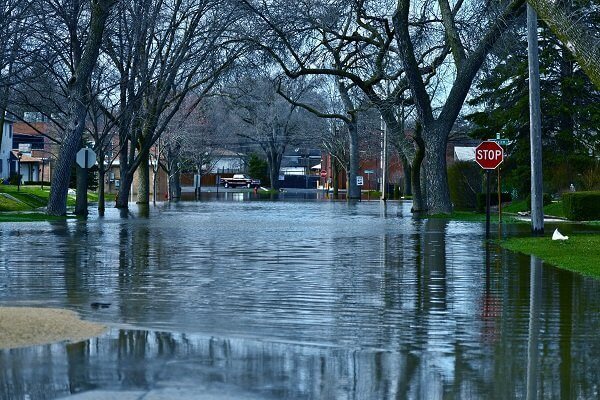This is Part 4 of a series of blog posts on important cases in the history of inverse condemnation claims. In this blog, we’ll explore significant cases that are of particular interest to property owners whose land has been damaged because of government flood control programs.
Previous pasts have addressed:
- Part 1: What Is The Takings Clause?
- Part 2: How Do Courts Determine Whether a Claim Involves Negligence or an Unconstitutional Taking?
- Part 3: Nature of Property Damage and State of Mind
Harris County Flood Control Dist. v. Kerr

In Harris County Flood Control Dist. v. Kerr, 499 S.W.3d 793 (Tex. 2016), the county and county flood control district that engaged in flood control efforts were not found liable to homeowners who suffered flood damage.
The ruling was based on the theory that, while they caused a compensable taking of the homeowners’ property by approving a private development without fully implementing a previously approved flood control plan, the county and district never intended to cause the flooding and, in fact, went to significant lengths to prevent flooding. They spent tens of millions of dollars over many years and never intended, as part of a flood control plan, to use the homeowners’ particular properties for detention ponds or drainage easements.
The only direct action the County took that allegedly caused the flooding was approving the private development, and even the homeowners admitted the flooding resulted from multiple causes, including Acts of God and the activities of other defendants.
Kopplow Dev., Inc. v. City of San Antonio
In Kopplow Dev., Inc. v. City of San Antonio, 399 S.W.3d 532 (Tex. 2013), the city’s construction of a stormwater detention facility would have subjected the land to flooding in the event of a 100-year-flood, which meant the landowner could no longer develop the property as previously approved.
While the land hadn’t actually flooded yet, the landowner’s inverse condemnation claim was based on the inability to move forward with construction of a development that had already been planned. The landowner had purchased the property to develop it, obtained development permits, including a vested rights permit, and filled the property to the 100-year flood level to develop it before the city constructed the project that rendered the land undevelopable unless it was filled again.
City of El Paso v. Mazie’s L.P.
In City of El Paso v. Mazie’s L.P., 408 S.W.3d 13 (Tex. App.—El Paso 2012, pet. denied), landowners alleged that a City engaged in acts that resulted in the flooding of their properties. The landowners claimed their property damage was caused by a diversion dam, detention pond and drainage system that was constructed, operated and maintained by the City.
They also claimed the City intentionally chose, through the construction and operation of the diversion dam and drainage system, to divert water from natural arroyos into a man-made drainage system, knowing that damage to the landowners’ properties was substantially certain to result and that increased diversion of new water from a new development created a situation in which a large storm would overwhelm the capacity of the man-made drainage system to move flood waters.
A fact issue, as to whether the City knew that flooding was substantially certain to occur as a result of its construction of the diversion dam and drainage system, precluded the grant of the City’s plea to the jurisdiction.
City of El Paso v. Ramire
In a similar case, City of El Paso v. Ramirez, 431 S.W.3d 630 (Tex. App.—El Paso 2014, no pet.), a critical issue in the inverse condemnation claim was whether the City’s continued operation and maintenance of a landfill was substantially certain to damage landowners’ properties.
A fact issue existed as to whether the City knew that its construction, operation, and maintenance of the landfill was substantially certain to damage landowners’ properties by continuing to flood them during heavy rains when the landfill’s retention ponds overflowed.
City of Keller v. Hall
In City of Keller v. Hall, 433 S.W.3d 708 (Tex. App.—Ft. Worth 2014, pet. denied), landowners brought an inverse condemnation claim against the city, claiming that various actions by the city, including widening an adjoining creek bed, raising the bed of an adjoining road and replacing a bridge on that road that passed over a creek, caused flooding of their property that was located within the 100-year floodplain.
The court of appeals concluded that factual questions existed about the city’s knowledge of whether its public works projects would result in flooding of the property, effectively turning it into a detention pond. These questions precluded a grant of the city’s plea to the jurisdiction in the case.
Sloan Creek II, L.L.C. v. N. Texas Tollway Auth.
In Sloan Creek II, L.L.C. v. N. Texas Tollway Auth., 472 S.W.3d 906 (Tex. App.—Dallas 2015, review denied), a tollway authority brought an action to condemn an easement for a tollway drainage system. The landowner brought an inverse condemnation counterclaim against the authority and the Texas Department of Transportation (“TxDOT”). The court of appeals held that:
- The designed discharge of rainwater runoff into a creek on the landowner’s property was not, by itself, a compensable taking or damage;
- Evidence that erosion necessarily resulted from the intended project design was insufficient to meet the knowledge component of the intent required for an inverse condemnation claim; and
- There was no evidence that the tollway authority or TxDOT knew the designed discharge of rainwater runoff would unnaturally erode the banks of the creek.
Stay tuned for the final post in this series, which will discuss two federal inverse condemnation claims that arose after Hurricane Katrina.
Frequently Asked Questions About Eminent Domain in Texas
In Texas, all levels of government generally have eminent domain power, including federal, state, county and municipal, as well as water districts and school districts. Public utility companies may also be granted eminent domain authority, such as for power lines or pipelines.
Read more
If your property is being condemn under under eminent domain, the U.S. and Texas Constitutions requite the condemning entity to pay the property owner “just” and “adequate” compensation. Unfortunately, in most circumstances, what the government entity considers to be fair compensation is actually a lot less than what the property owner is entitled to.
Learn more
Absolutely! While a condemning entity is supposed to offer “just and adequate” compensation to landowners, the truth is that most often hire professional agents to acquire land quickly and cheaply. You absolutely have the right to refuse the government’s initial offer, and it is mostly likely the smartest move you can make.
Read more
Eminent Domain Case Results
The Texas eminent domain attorneys at Dawson & Sodd have helped many landowners protect their property rights. In many cases, we’re able to significantly increase the amount of compensation received for a property being taken through eminent domain. In some cases, we’re able to stop the eminent domain action. In the case of a convenience store owner in Farmers Branch whose property was targeted by TxDOT for the I-35E project. Our attorneys were able to establish that the State lacked legal authority to acquire the land and got the condemnation action dismissed.
Protect Your Rights as a Texas Landowner
At Dawson & Sodd, our eminent domain attorneys help Texas landowners protect their land rights. We understand the complex laws governing eminent domain cases, including inverse condemnation. We will help you maximize the amount of compensation you receive for your land.
Contact us today for assistance.






